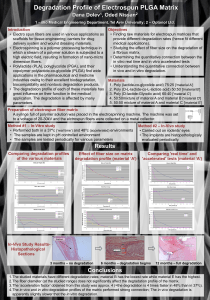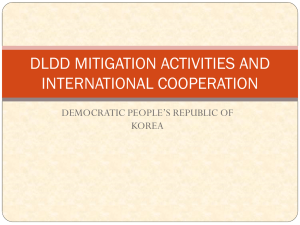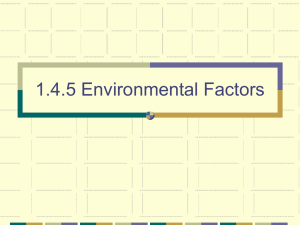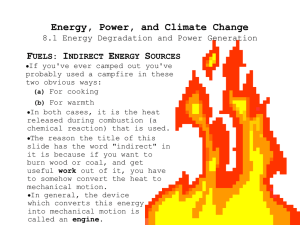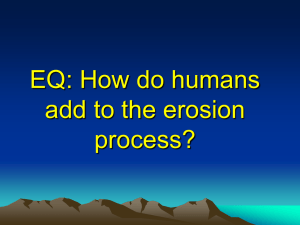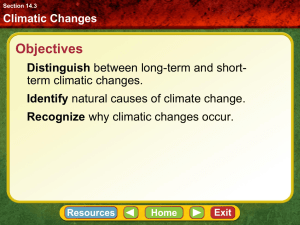Climate and Land Degradation
advertisement
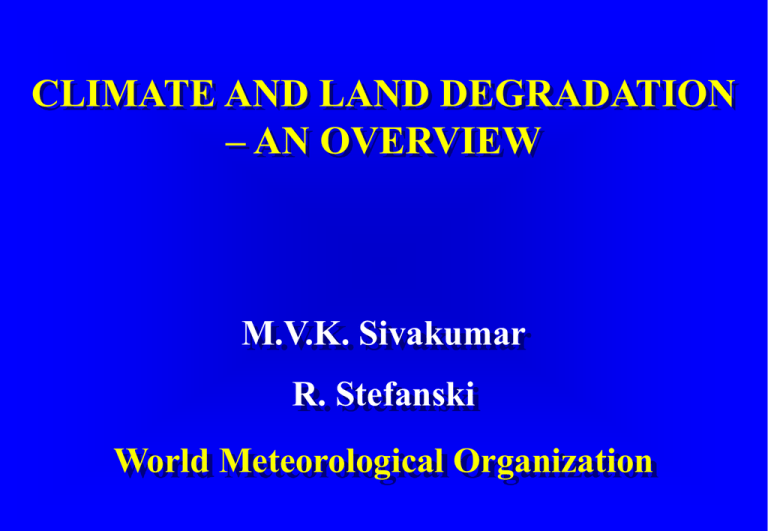
CLIMATE AND LAND DEGRADATION – AN OVERVIEW M.V.K. Sivakumar R. Stefanski World Meteorological Organization Presentation • Climatic factors in the definition • Importance of the issue • Climatic consequences of land degradation • Important climatic factors in land degradation - Rainfall - Drought - Solar radiation , temperature and evaporation - Wind - Wild fires • Climate change and Land Degradation • Conclusions Desertification is land degradation in the arid, semi-arid and dry sub-humid areas resulting from various factors, including climatic variations and human activities Importance of the issue • Sustainable development of affected countries can only come about through concerted efforts based on a sound understanding of the different factors that contribute to land degradation around the world. • It is important that greater attention be paid to understand the role of different climatic factors in land degradation. • To accurately assess sustainable land management practices, the climate resources and the risk of climaterelated or induced natural disasters in a region must be known. Climatic consequences of land degradation • The interaction between land surface and the atmosphere involves multiple processes and feedbacks, all of which may vary simultaneously. • It is frequently stressed that the changes of vegetation type can modify the characteristics of the regional atmospheric circulation and the large-scale external moisture fluxes. • Changes in surface energy budgets resulting from land surface change can have a profound influence on the earth’s climate. Climatic consequences of land degradation (contd.) • Following deforestation, surface evapotranspiration and sensible heat flux are related to the dynamic structure of the low-level atmosphere and could influence the regional, and potentially, global-scale atmospheric circulation. • Fragmentation of landscape can affect convective flow regimes and rainfall patterns locally and globally. • Surface parameters such as soil moisture, forest coverage, and transpiration and surface roughness may affect the formation of convective clouds and rainfall through their effect on boundary-layer growth. Climatic consequences of land degradation (contd.) • Land use and land cover changes influence carbon fluxes and GHG emissions which directly alter atmospheric composition and radiative forcing. • Emissions due to land use change include those by deforestation, biomass burning, conversion of natural to agricultural ecosystems, drainage of wetlands and soil cultivation. • Depletion of soil organic C pool has contributed 78±12 Gt of C to the atmosphere, of which about onethird is attributed to soil degradation and accelerated erosion and two-thirds to mineralization. Climatic Factors in Land Degradation • Climate exerts a strong influence over dry land vegetation type, biomass and diversity. • Climatic stresses account for 62.5% of all the stresses on land degradation in Africa (Natural Resources Conservation Service of USDA) • These stresses include high soil temperature, seasonal excess water; short duration low temperatures, seasonal moisture stress and extended moisture stress Weather- climate- and water-related hazards that occurred between 1993-2002, were responsible for 63 per cent of the US$ 654 billion damage caused by all natural disasters. Rainfall Rainfall is the most important climatic factor in determining areas at risk of land degradation and potential desertification. Rainfall plays a vital role in the development and distribution of plant life, but the variability and extremes of rainfall can lead to soil erosion and land degradation. With normal climatic variability, some years the water deficits can be larger than others but sometimes there can be a several year period of water deficit or long-term drought. Rainfall can erode soil by the force of raindrops, surface and subsurface runoff, and river flooding. Soil erosion is the detachment and movement of soil particles by the erosive forces of wind or water. When it rains, drops up to 6 mm (0.24 inch) in diameter bombard the soil surface at impact velocities of up to 32 km per hour (20 mph). This force throws soil particles and water in all directions on a distance of up to 1 m (3.3 feet). Water Erosion Prediction Project Model A process-based, distributed parameter, continuous simulation, erosion prediction model for use on personal computers running Windows 95/98/NT/2000/XP. The current model version (v2004.700) available for download is applicable to hillslope erosion processes (sheet and rill erosion), as well as simulation of the hydrologic and erosion processes on small watersheds. Excessive rainfall events produced by thunderstorms, hurricanes and typhoons, or mid-latitude low-pressure systems can produce a large amount of water in a short period of time across local areas. Floods Dryland rivers have extremely variable flows and river discharge and the amount of suspended sediments are highly sensitive to fluctuations in rainfall as well as any changes in the vegetation cover in the basins. Flood Forecasting Flood forecasting is complex process that must take into account many different factors at the same time. National Hydrological Services and Meteorological Services under the auspices of the WMO undertake flood forecasting based on quantitative precipitation forecasts (QPFs), which have become more accurate in recent years. Forecasting also needs to be a cooperative and multidisciplinary effort. Recently there has been a shift to Integrated Flood Management. Drought is the consequence of a reduction in the amount of rainfall over an extended period of time often associated with other climatic factors - high temperatures, high winds and low relative humidity - that can aggravate the severity of the event. Drought vulnerability Probability Within every society, there is a certain capacity to cope with drought. P (x) Coping range Drought Societal changes can increase or decrease this coping range. Flooding X (e.g. precipitation, soil moisture, etc.) Keys to effective drought risk management and mitigation • Drought plans should contain three basic components: monitoring and early warning, risk assessment, and mitigation and response. • Monitoring and early warning systems provide the foundation for an effective drought mitigation plan. • Integrate data from multiple sources • Increased emphasis on decision-support tools Solar radiation, temperature and evaporation Dryland climates have intense solar radiation almost throughout the year and it sets the broad limits of evaporation High temperatures affect soil moisture, biological activity and contribute to high evaporation rates The high evaporation which greatly exceeds precipitation leads to accumulation of salts on soil surface. On a degraded land, the land surface itself influences the evaporative demand by the albedo and surface roughness, the latter affecting turbulence. Wind • Drylands are affected by moderate to severe land degradation from wind erosion and there is evidence that the frequency of sand storms/dust storms in increasing. • In the arid and semi-arid zones of the world, 24% of the cultivated land and 41% of the pasture land affected by moderate to severe land degradation from wind erosion. • Sand and dust storms are hazardous weather and cause major agricultural and environmental problems in many parts of the world. Total annual production of dust world-wide by deflation of soils and sediments was estimated to be 61 to 366 million tons. Sand and dust storms move forward like an overwhelming tide and strong winds take along drifting sands to bury crops Classification of sand-dust storms Type of storm Wind velocity (Beaufort) 6 Visibility (m) Secondary strong storms 8 200-500 Strong storms 9 < 200 Feeble storms 500-1,000 Wind Erosion Prediction System (WEPS) A process-based, daily time-step model that predicts soil erosion by simulation of the fundamental processes controlling wind erosion. WEPS can calculate soil movement, estimate plant damage, and predict PM-10 (particles with a diameter of less than 10µg) emissions when wind speeds exceed the erosion threshold. It also provides users with spatial information regarding soil flux, deposition, and loss from specific regions of a field over time. Wild Fires, Land Degradation and Atmospheric Emissions Annually affect 1.02 billion ha of boreal and temperate forests, 2.04 billion ha of tropical rain forests and 500 m ha of tropical and subtropical savannas, woodlands, and open forests. Biomass burning contributes significant amounts of trace gases and particulates to the atmosphere. Development of a Global Early Warning System for Wildland Fire Fire causes: land-use fires, carelessness, arson, natural wildfire Some uncontrolled fires become large disastrous events There are many negative economic, social, and environmental impacts of uncontrolled wildland fire. Ensemble forecasts Weather Observations Current fire weather Forecast fire weather FWI System Current fire danger Hot spot data Future fire threat Historical databases Calibration tools Fire data 40-year historical weather analyses Basic structure of the early warning system for wildland fire (EWS-Fire) Forecast fire danger Solid lines indicate daily procedures; dashed lines indicate periodic recalibration of fire danger levels based on updated databases. Climate Change Projected Temperatures During the 21st Century Are Significantly Higher Than at Any Time During the Last 1000 Years Land Degradation: Relations with Climate Change Climate Change Demography Gaseous Emission (CO2, methane) Material Wastes Economic Intensity (including agriculture, energy, etc) Pressure on natural resources (water, soils, forests, etc) Strat. Ozone depletion Biodiversity loss Freshwater depletion Degraded ecosystems (soil, chemical, etc) Land degradation oDesertification oDeforestation oSalinization oCompaction oSoil erosion Climate change and land degradation • CO2-induced climate change and land degradation remain inextricably linked because of feedbacks between land degradation and precipitation. • Climate change might exacerbate land degradation through alteration of spatial and temporal patterns in temperature, rainfall, solar radiation, and winds. • Climate change—especially changes in climate variability through droughts and flooding—will make addressing the water resources problem more complex. Climate change and land degradation What needs to be done ? • Greater attention to critical areas and socioeconomic conditions at the local and regional level that could aggravate climate change impacts • The reduction of green house gas (GHG) emissions must still remain the primary goal to be accompanied by integrated natural resource management (including land use) • Promotion of sustainable use of natural resources in ways that maintain a climate favourable to human life and sound ecosystems. CONCLUSIONS • There is no concerted effort at the global level to systematically monitor the impacts of different climatic factors on land degradation in different regions and for different classes of land degradation. • It is important to identify the sources and sinks of dryland carbon, aerosols and trace gases in drylands. This can be effectively done through regional climate monitoring networks. • Such networks could also help enhance the application of seasonal climate forecasting for more effective dryland management. CONCLUSIONS • Data from meteorological satellites could be used to supplement knowledge of meteorological conditions influencing land degradation, especially over areas inadequately covered by ground-level observations. • There is a need for a project on Climatic Factors in Land Degradation (CFILD) that places emphasis making available all critical climatic data through easy mapping tools for use by the parties to the UNCCD. WMO can take a lead in this regard. • An Ad-Hoc Group on Climate and Land Degradation could be appointed by the CST of UNCCD to examine these issues. Thank You !

